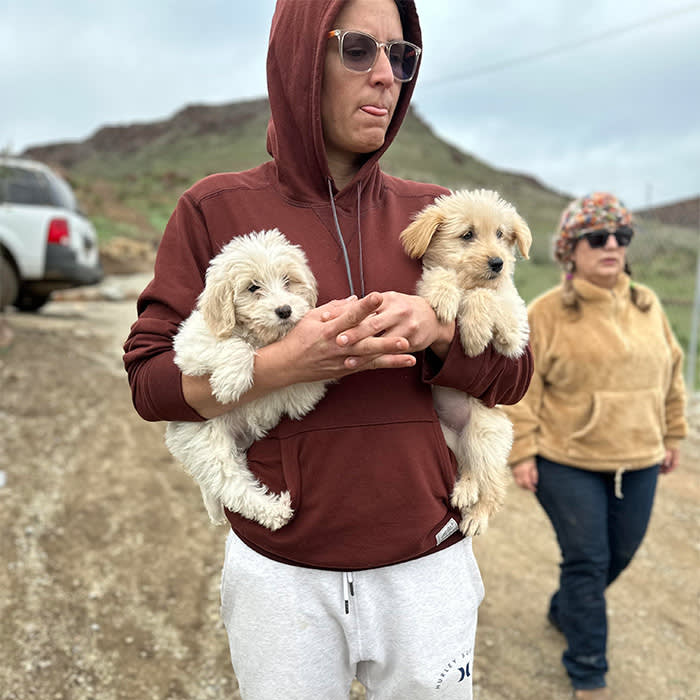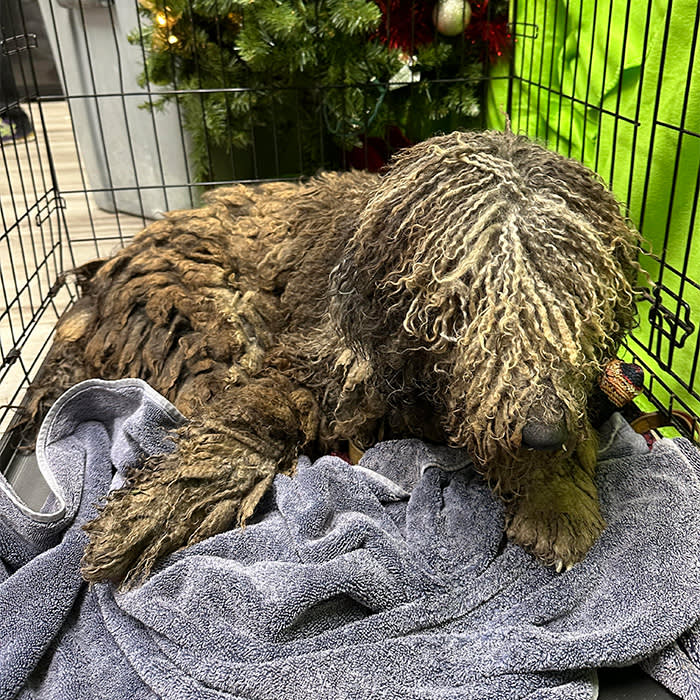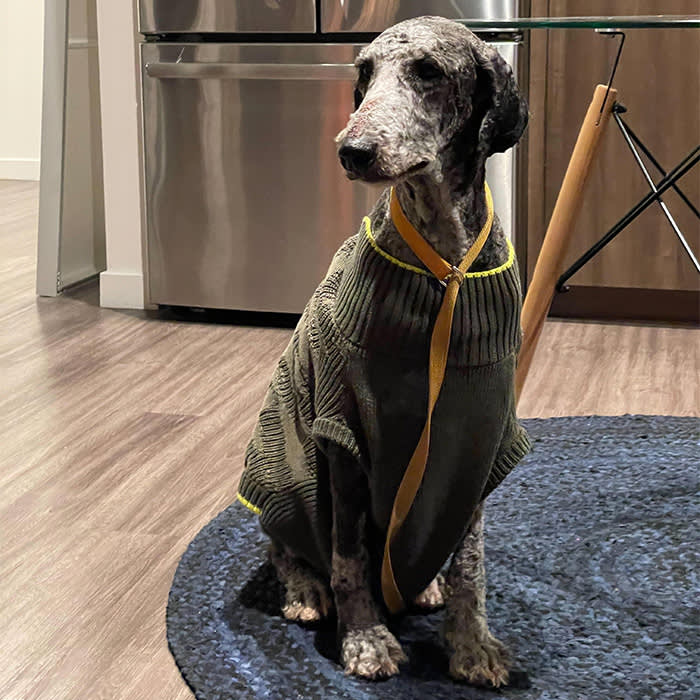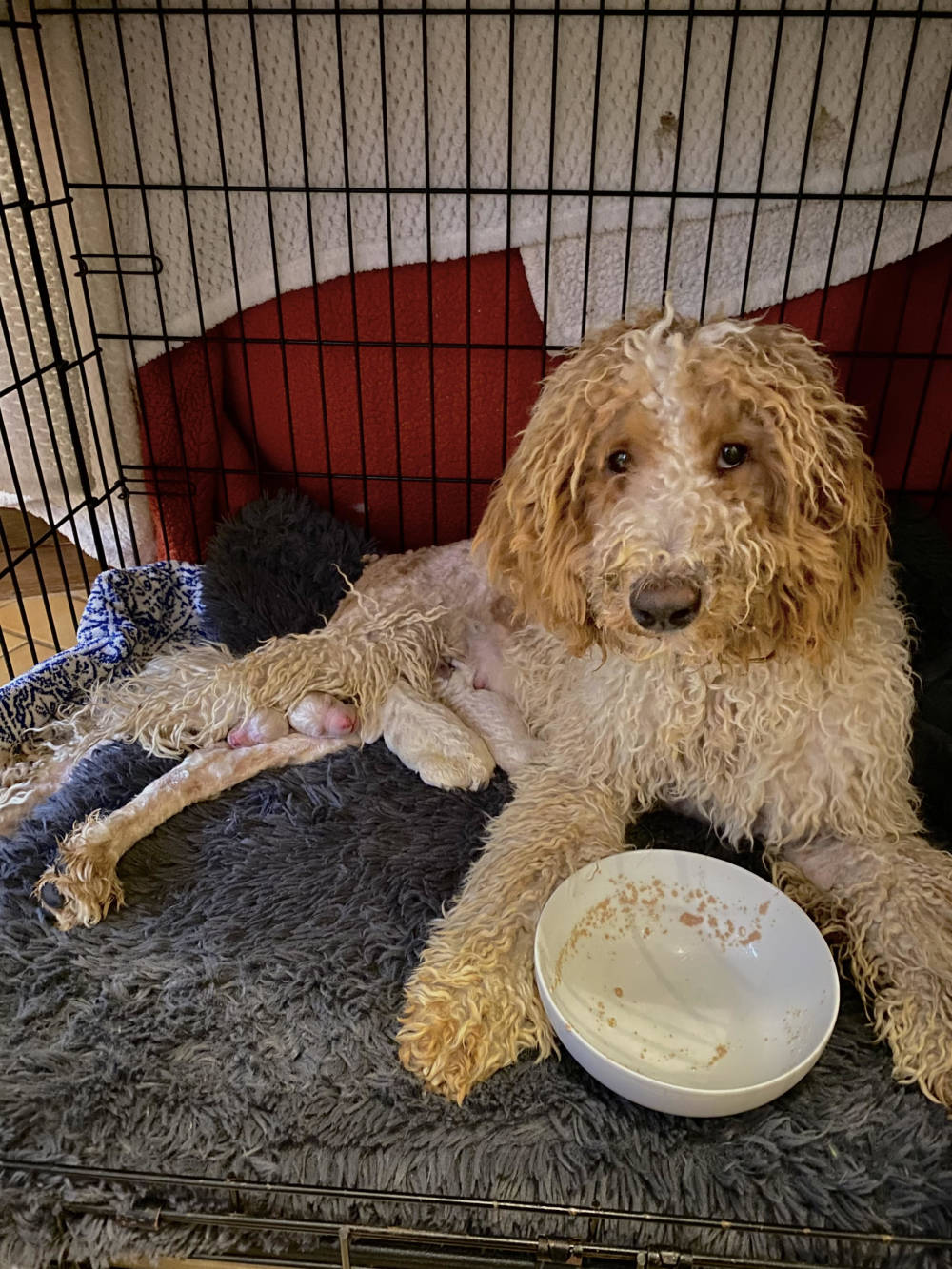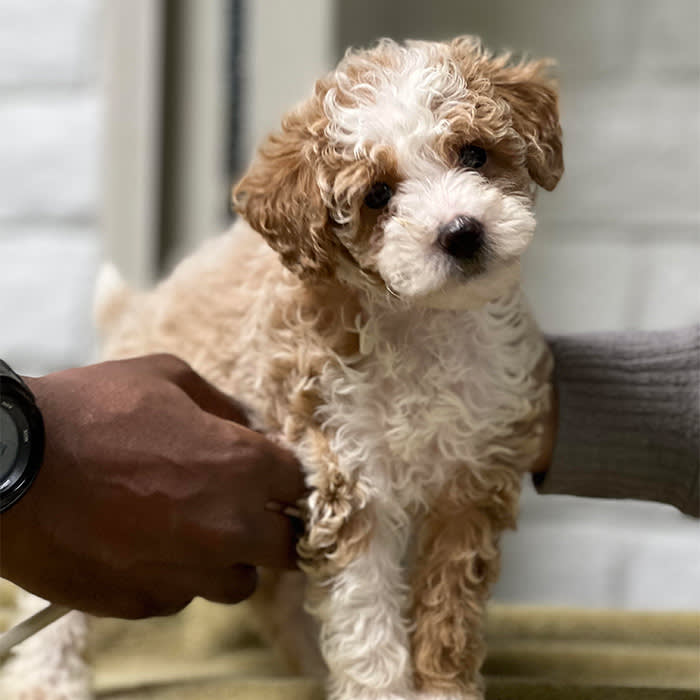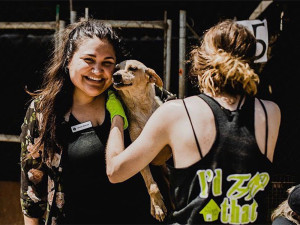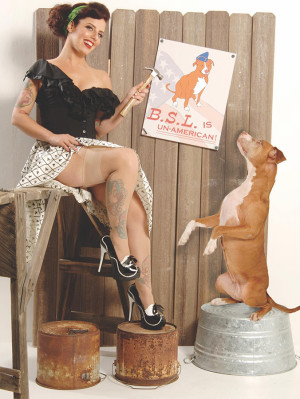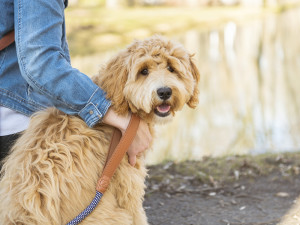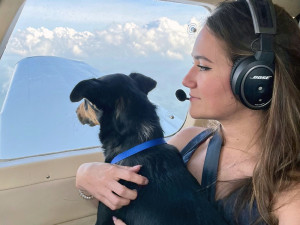How The Animal Pad Rescued 111 Doodles From a Backyard Breeder
Further proof that you can — and should — adopt rescued designer dogs.
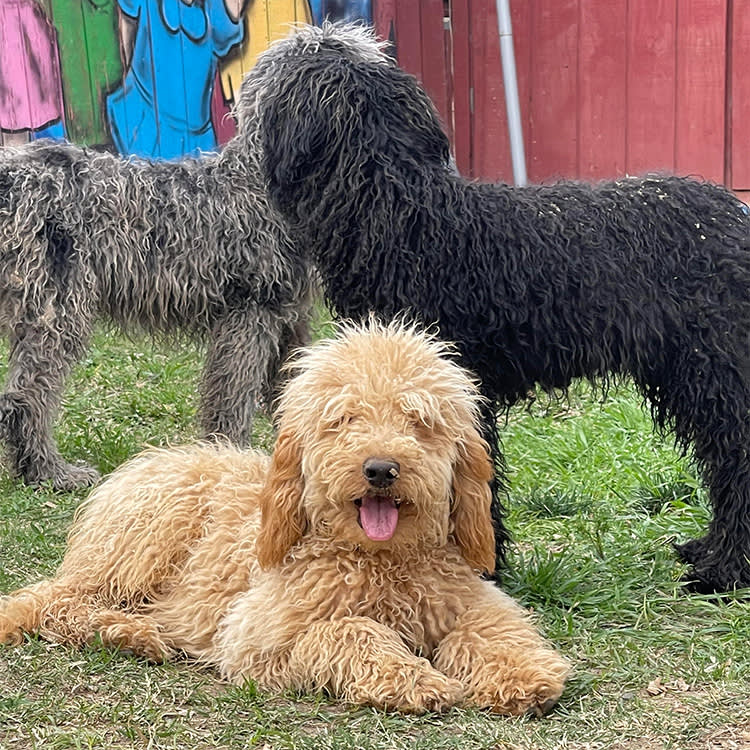
share article
It all started with a Facebook message.
“There’s a situation with a breeder of Doodles in the La Misión area,” Lauren Botticelli — the executive director of The Animal Padopens in a new tab, an all-breed, non-profit dog rescue organization based in San Diego — recalls the message, which was sent at the end of 2022, read.
The Animal Pad is connected with a number of rescue groups in the Baja California state, located in northwestern Mexico, and the organization regularly rescues dogs in the country. But those dogs are almost always street dogs. Never before, Botticelli tells The Wildest, had the Animal Pad been contacted about a breeder — especially a breeder of designer breeds.
At first, Botticelli was kept mostly in the dark. The Animal Pad was given two dogs from the breeder via a transporter and told they couldn’t post anything publicly about the dogs, who were “severely shutdown and under-socialized,” Botticelli adds.
“I just fixated on these dogs and what they must have gone through,” Botticelli says. Though she didn’t know much about the conditions they came from, she worked her network in Baja California to learn more. Botticelli discovered that a number of local rescuers were working with the authorities to try to shut down the breeder, but none had been able to set foot on the property to assess the extent of the situation.
“I still don’t know why she trusted us over anyone else,” Botticelli says of the breeder, with whom Botticelli eventually got in direct contact and who invited her and a group of The Animal Pad volunteers to her property. The breeder signaled that she was open to rescuers taking some of the dogs off of her hands, specifically those she did not think she could sell.
Confronting Reality
The rescuers seized the opportunity and visited the property. What they found was nothing short of a nightmare. The breeder had over 150 dogs on her property. Dozens of large dogs were enclosed in small yard spaces. Puppies were piled in crates. All were living in filth. The dogs were ungroomed and matted — some so severely they couldn’t see. They were left to fight for food and water and, in some instances, killed each other.
“It took everything in us to hold it together and know that, for the betterment of the dogs, we couldn’t say anything,” Botticelli says.
At first, the breeder allowed the volunteers to take the dogs she deemed “ugly” and “weirdos” — dogs she didn’t believe would make her money.
“We played along with that,” Botticelli says. “We took those dogs in and said we would continue to help her however we could…All the while, we’re behind the scenes trying every possible thing to figure out how we can help shut her down.” Botticelli and her team documented the conditions on the property to send to the authorities. “It was kind of like an undercover operation,” she says.
The rescuers were invited back twice over the span of three days and observed the breeder’s increasingly disturbing behavior. “She was taking slip leads and hitting the dogs with them and wondering why the dogs were shying away from her,” Botticelli recalls. “She was throwing buckets and things at dogs on the property and then breaking down sobbing.”
Taking Action
Botticelli explains that, once her team began efforts to catch and rescue the pups, they resisted and ran from them because this “was all they had ever known, and this was a very scary situation for them.” To make matters worse, the breeder was screaming, “See, they don’t want to go with you! This is paradise.” Botticelli recalls that she kept screaming that phrase: “This is paradise.” She adds that this “really stuck” with her, “because I think [the breeder] truly believed it.”
The rescuers took as many dogs as they could during these trips and then, later the same week, learned that the breeder had been arrested. She was not arrested for animal cruelty — though she had been previously arrested on that charge in the U.S., according to Botticelli. This time, she was threatening the authorities; the police had come to the breeder’s property, found puppies living inside the breeder’s car without food or water, and confiscated them. Per Botticelli, this sent the breeder into a “tailspin,” and she “chased them to the police station, went into the police station, got out of her car and threatened everyone — threatened their lives.”
After the arrest, the police and the breeder’s landlord gave Botticelli and her team the authority to go to the property and rescue all of the dogs there, and they immediately sprang into action. Around 15 volunteers joined Botticelli, and local rescuers — including Los Adoptablesopens in a new tab — came to help and tried to rescue all of the dogs.
“I wish we could have explained to [the dogs] that us putting this leash around their neck is the best thing that’ll ever happen to [them],” Botticelli says of the Doodles, who resisted the rescuers out of fear. “It was so clear how abused they had been and how traumatizing this was. It broke my heart, it broke my team members’ hearts, to have to do this to them and put them through this final trauma even though we knew this is what needed to happen and was ultimately for the best.”
Finally, in the early hours of the next morning, the volunteers had to leave 13 dogs on the property who were “way too skittish, [who] had watched all of their friends captured and were like, ‘There is no way this is happening to me.’” The rescuers transported about 60 dogs to a local safehouse and 30 crossed the border to the U.S.
Of course, Botticelli wasn’t going to leave the final 13 dogs behind. It rained for the next few days, which made the property, which is located off of an unpaved road, inaccessible. But eventually, volunteers at Los Adoptables were able to successfully save the rest of the dogs — many of whom had dug caves into the property and hid there. Two days later, two of those dogs gave birth to litters of five and six puppies, respectively.
Moving Forward
Once back in the States, the dogs were boarded at both The Animal Pad’s facility as well as at a nearby kennel and given medical assessments. All of them came with giardia, parasites, and ear infections, according to Botticelli.
In addition to medical treatment, the dogs were groomed. Botticelli and her team worried the dogs may resist grooming so soon after so much upheaval but, “most of them have fallen asleep on the grooming table,” Botticelli says. “It’s just relief, getting those mats out and just feeling like ‘Oh my god, this feels so good.’”
The outpouring from the public has been overwhelming; of the 111 dogs Botticelli and her team rescued, just nine are left waiting to be adopted or to enter a foster home. Therein lies the bittersweet nature of this particular rescue. “The only reason we were able to do a rescue of this magnitude is because they were Doodles,” Botticelli said. “That makes me both so happy for these dogs and so sad for so many others that get overlooked.”
An Ongoing Problem
Laws around breeding abuses, such as what happened in this case, are incredibly weak. In the U.S., existing dog breeding laws generally do not applyopens in a new tab to small-volume breeders. The Animal Welfare Actopens in a new tab sets federal standards opens in a new tab for research laboratories’ treatment of animals but does not include breeders that sell to consumers. State laws that require commercial pet breeders to obtain licenses ignoreopens in a new tab small-volume breeders, and while some states have local laws that regulate small-volume breeding, the lack of uniformity results in lack of enforcement — not to mention that breeders can easily relocateopens in a new tab to unregulated states.
In fact, The Animal Pad heard from a number of people in the San Diego area who had bought their Doodles from this breeder, who targeted customers in the area and in Orange County. Among the many hard lessons this rescue brings is this: You do not have to go to a breeder to find the designer dog you’ve been looking for. There are, unfortunately, many breeders, whose practices are peppered with red flagsopens in a new tab (some far more severe than others). Thankfully, there are also rescues like Animal Pad, as well as breed-specific rescuesopens in a new tab that make it their mission to give these abused dogs a better life. Please consider researching those rescues if your heart is set on a specific breed.
This particular story, thankfully, ends happily — and with an important lesson for people who had previously bought dogs from this breeder in Mexico. Many of those folks stepped up to foster or adopt Animal Pad’s group of rescued Doodles.
“I keep telling people, I’m happy for their dogs, that their dogs got out and are loved and probably don’t even remember the horrors that they came from,” Botticelli says. “I don’t want anyone to feel guilty for what they did, but, instead, help. I’m happy they’re going this route, that they’re learning you need to do your due diligence before you get an animal of any sort, for so many reasons.”
Botticelli also hopes that others will learn from these dog purchasers’ mistakes. When buying a dog, it’s a red flag (remember it’s crucial to look for those!) if a breeder does not let you on their property. Botticelli heard from one potential customer who had asked the breeder to pick up a dog on her property, then never heard back from the breeder. “Anybody legitimate would be willing to show you where the breeding is taking place,” Botticelli says.
As far as Botticelli knows, the breeder is not in jail anymore and, legally, could acquire more dogs and pick up right where she left off. “We’re going to do everything we can do obviously to ensure that doesn’t happen,” Botticelli says. “Luckily, the part of Baja she lives in has eyes and ears everywhere, and we would definitely hear [if she began breeding again].”

Julie Zeilinger
Julie Zeilinger is a NYC-based writer and editor whose writing has been published in Marie Claire, Vox, HuffPost, Forbes, and other publications. She is also the author of two books: College 101: A Girl’s Guide to Freshman Yearopens in a new tab (2014) and A Little F’d Up: Why Feminism Is Not a Dirty Wordopens in a new tab (2012). She is the mom to Baloo, a two-year-old Bichpoo and foster mom to dogs via Badass Animal Rescueopens in a new tab.
Related articles
![A woman smiling with a dog at an animal rescue service event.]() opens in a new tab
opens in a new tabAs Shelters Fill Up With Dogs, The Animal Pad Volunteers Roll Up Their Sleeves
The San Diego-based rescue’s 300 volunteers take saving Mexican street dogs as seriously as a full-time job (but have fun doing it).
![Deirdre Franklin dressed as a pinup model holding one of her calendars while sitting on a wooden table next to a Pitbull dog sitting on its hind legs looking up at her]() opens in a new tab
opens in a new tabPinups for Pitbulls Rolls Up the Victory Curls For the Pups Who Need It Most
Back in the day, pinup models donned their victory rolls to boost wartime spirits. Now, they do it to advocate for a much-maligned dog breed. Deirdre Franklin, the founder of Pinups for Pitbulls, explains how a burlesque hobby evolved into a life-saving non-profit.
![Happy Labrador Retriever sitting on the floor]() opens in a new tab
opens in a new tabDid You Know 25% of Shelter Dogs Are Purebred?
If your heart is set on a purebred pup, start your search at breed-specific rescue organizations.
![designer dog breed Labradoodle on a leash looking at the camera]() opens in a new tab
opens in a new tabFrom Goldendoodles to Puggles — the Truth About “Designer Dogs”
Do your research. Know the facts.
![A brunette woman holding a black dog with a blue collar, she is wearing headphones and a microphone attachment while seated in a plane with the clouds and sky showing through the window]() opens in a new tab
opens in a new tabPilots to the Rescue Has Flown Nearly 400 Animals to Safety This Year
With the help of flight, this nonprofit is saving animals and relocating them to loving homes across the country.
